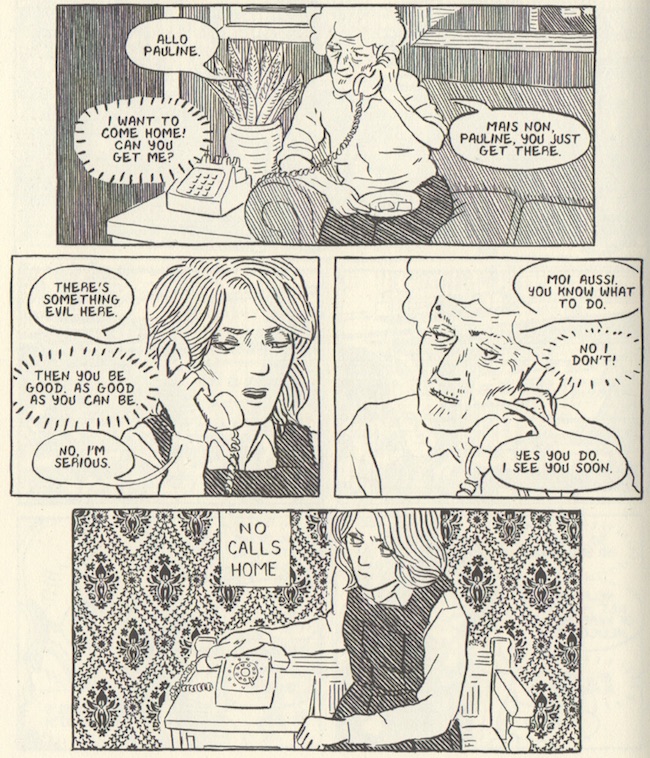As far as presentational choices go, designing a comic so that it looks somewhat generic, albeit slightly “off,” is a risky one. The covers of these “Hobtown Mystery Stories,” written by Kris Bertin and drawn by Alexander Forbes, seem modeled after certain vintages of Hardy Boys or Nancy Drew mysteries, with fairly flat drab colors that I believe are painted, though in a way that lends no shading, only a sense of lacquered texture if inspected closely. The Cursed Hermit is the second installment in the series, following The Case Of The Missing Men, which came out in late 2017. It makes its pitch to those familiar with the visual tropes of young detectives, whose sense of mystery will be intrigued enough to figure out what exactly is going on.
Such a reader would not even necessarily expect these books to be comics, but they are, and attractive ones. Forbes’ art is quite dynamic in black and white, reminiscent in some ways of Simon Gane, though it retains its power at a reduced size in a way I don’t think Gane’s would. There’s a push and pull to the rendering. Many panels just depict a human figure, and these have an elegant smoothness to them, and a sense of economy in how characters are distinguished from one another by their facial features. When these characters are set inside backgrounds, there’s a sense of contrasting textual hatching effects that maintains readability while bearing the mark of an obsessive hand. Reading the pages as they transition between these effects, there’s a vivid tactility that feels uncanny. We intuitively understand the scale the art is drawn at from its usual smoothness, but then way more will be more rendered than would have previously been thought possible if the scale you were imagining is correct. There’s a dissociative effect similar to meditating on how our perception of size is built around our bodies and the eye’s capacity to take in light, but the molecular and atomic bonds that constitute us are far smaller than makes sense to contemplate, and the extremes of space lie beyond human reckoning as well.

This works well for a horror story. The Cursed Hermit follows two members of the Hobtown Junior Detective Club as they are selected to attend a cloistered-off academy, in the mountains overlooking their small town. The mystery it then becomes incumbent for them to solve is what exactly is going on at the school, and includes ghosts, possession, occult objects, and generation-spanning conspiracies of the ruling class. The conspiracy calls for the rigid enforcement of gender roles, which is a horror the sort of stiff quality of Forbes’ art, the clip-art like returning to the same shifting faces, recalls. We’re incessantly being offered the comfort of the recognizable form, as madness swirls all around. Bertin’s script makes a wise choice, matching the presentation by breaking the story up into chapters. Each is focused enough to feel somewhat abbreviated, which keeps the story moving effectively while still feeling like there are larger secrets being left untold. Each new chapter gets to reset the feeling of in-media-res mystery, whereas an unbroken procession of pages would suggest a steady pace for the story to reveal itself.

Breaking the story up into chapters suggests serialization, familiar from both TV comic books and TV shows. There’s also a certain visual similarity between Forbes’ art and Yummy Fur era Chester Brown, which feels appropriate for a work that almost seems like a Canadian answer to the visions of Americana in David Lynch. Lynch has a deep body of work, the Hobtown Mysteries recall the most iconic examples, Blue Velvet and Twin Peaks. It’s not as dark as either, nor is it as rich. Twin Peaks is a genuinely form-destroying bit of television. The Cursed Hermit is more a work that’s operating within the outline of a genre David Lynch created than anything comparably revolutionary. However! There is something notable not just about the comic’s distinct sense of visual style, which maps neatly onto the generally-agreed-upon “look” of the show; but also its sense of visual effects that matches Lynch’s own willingness to use a corny video effect or something stupidly ugly, for the sake of contrast. While one can see this as a further mimicry, to me it speaks to creators that know what transcendence is, and that you get there by not being overly self-conscious, which a lot of imitators miss.

This invocation of David Lynch in the context of contemporary work, all about teens, might put you in the mind of the popular TV series Riverdale, which places the familiar names of Archie comics stand-bys inside Lynch-indebted aesthetics in a way which maybe seems analogous to this comic’s work with the teen detective genre. I haven’t watched Riverdale, but I’ve heard the chatter, and here are the distinctions based on my understanding: One, it seems like Riverdale has an anxiously pulpy sense of pacing as it runs through its plots, while these Hobtown comics seem very deliberately paced. Two, the storytelling in Hobtown is distinctly not horny. The Cursed Hermit pretty openly posits chastity and platonic friendship as virtues and strengths with which the protagonists navigate the complexities and corruptions of adult behavior. This morality connects it to the very work intended for preadolescent readers that its choice of presentation posits the book as. It also allows the characters to be likable without appealing to an adult audience’s sense of lecherous voyeurism. It’s not Fire Walk With Me, but Snowy Walk With Teens remains plenty eerie, and pretty nice.







